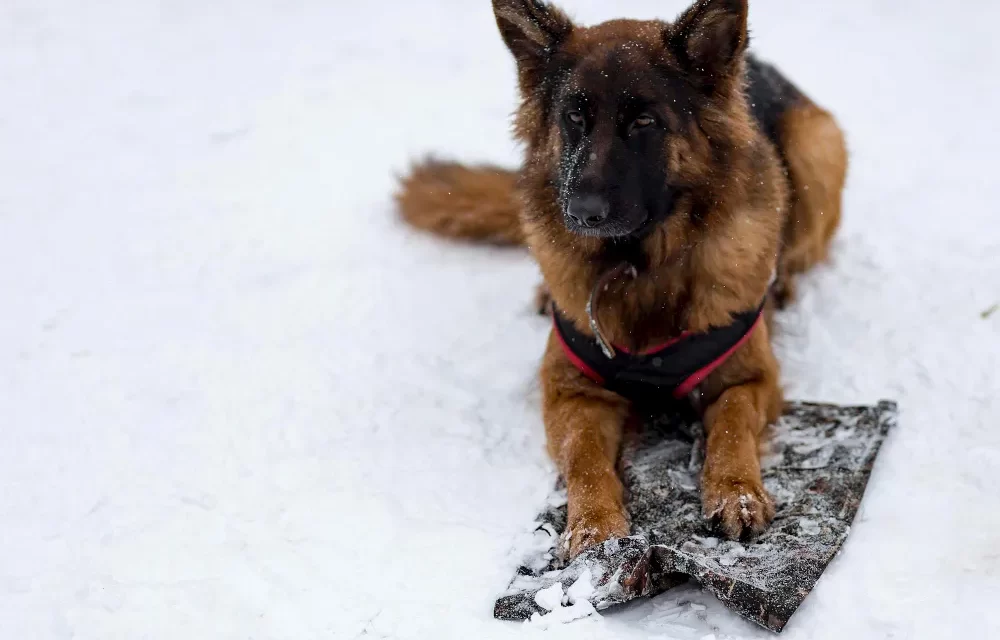Winter is coming, and if you’re a German Shepherd parent, you might be wondering: “How well does my furry friend handle the cold?” The good news is that German Shepherds are naturally equipped to deal with cold temperatures better than many other dog breeds. But like any responsible pet owner, you’ll want to know exactly how to keep your loyal companion safe, comfortable, and happy throughout the winter months.
In this post, we’ll explore how cold is too cold for German Shepherds, what factors affect their ability to tolerate cold weather, and practical tips on how to keep your dog safe, warm, and comfortable during those snowy days. Whether you’re caring for a playful puppy or a seasoned senior, you’ll find everything you need to protect your loyal companion all winter long.
German Shepherds and Cold Weather: Built for It… to a Point
German Shepherds come with their very own winter gear, a remarkable double coat that’s like wearing a high-tech outdoor jacket. This isn’t just regular dog fur; it’s a sophisticated two-layer system designed by nature itself.
The outer layer, called the guard coat, consists of longer, coarser hairs that act like a waterproof shell. These hairs repel moisture and create the first line of defence against wind and cold. Underneath lies the undercoat, a dense, fluffy layer of shorter hairs that work like insulation, trapping warm air close to your dog’s skin.
This double coat system is why you’ll often see German Shepherds happily romping through snow while other dogs are shivering. Their ancestors worked in harsh German winters, and that genetic programming is still very much alive in a German Shepherd.
So, How Cold Is Too Cold for a German Shepherd?
While German Shepherds are cold-weather champions, they’re not invincible. Understanding temperature thresholds helps you make smart decisions about your dog’s winter activities.
- Comfortable Range (Above 7°C/45°F): Your German Shepherd is perfectly comfortable and can enjoy normal outdoor activities without any special precautions.
- Caution Zone (0°C to 7°C/32°F to 45°F): Most healthy adult German Shepherds handle this range well, but start paying closer attention to their behaviour. Puppies, senior dogs, or those with health issues may need extra care.
- Cold Alert (Below 0°C/32°F): This is where you need to be more careful. While many German Shepherds can still enjoy outdoor time, limit exposure and watch for signs of discomfort.
- Danger Zone (Below -12°C/10°F): Even the most winter-hardy German Shepherd should have limited outdoor exposure. This is a serious cold that can lead to frostbite and hypothermia.
Remember, these are general guidelines. Factors like wind, humidity, your dog’s age, health, and individual tolerance all play a role in how well they handle cold weather.
Factors That Influence Cold Tolerance
Age
Puppies and senior dogs are more sensitive to the cold. Puppies haven’t developed full insulation or body control yet, and older dogs may have joint pain or weakened immune systems, making it harder for them to stay warm.
Health
Dogs with medical conditions, especially thyroid problems, arthritis, or a weakened immune system, may struggle more in cold weather. Always consult your vet if your German Shepherd has any health issues before spending extended time outside in the cold.
Weight and Body Fat
Thinner dogs lose heat faster. While German Shepherds have a strong build, low body fat or being underweight can reduce their ability to stay warm. On the flip side, obese German shepherds get cold and may be less mobile in snow or ice.
Acclimation
A dog that’s used to living in cold climates will generally tolerate winter better than one that lives in a warmer region. Gradual exposure helps German Shepherds adjust to colder air temperatures, but sudden changes can be a shock to their system.
Coat Condition
A healthy, thick double coat is your GSD’s natural defence against the cold. Dogs that have been shaved, have patchy fur, or are shedding heavily won’t retain heat as well. Regular grooming helps maintain the coat’s insulating properties.
Warning Signs: When Your German Shepherd Is Too Cold?
Your German Shepherd can’t tell you when they get too cold, so learning to read their body language is important. Watch for these warning signs:
- Shivering or trembling – This is the most obvious sign your dog is cold
- Lifting paws repeatedly – Cold or painful paws from ice and snow
- Reluctance to walk or play – If your usually active dog seems hesitant, they might be uncomfortable
- Seeking warm spots – Trying to get close to you, heading toward the house, or finding sunny patches
- Whining or seeming anxious – Vocalising discomfort or distress
- Slow, stiff movements – Cold can make joints ache, especially in older dogs
If you notice any of these signs, it’s time to head inside and warm up.
How to Keep Your German Shepherd Warm in Winter?
Even if your German Shepherd loves the snow, don’t assume they’re immune to the cold. Here’s how to help them stay safe with detailed explanations for each strategy:
1. Limit Outdoor Time
When the temperature drops below freezing, even thick-coated German shepherds can get cold fast. Try to keep walks and outdoor play short, especially when it’s windy or wet. Around 20–30 minutes at a time is usually safe, but always keep an eye on their body language. If they’re lifting their paws, shivering, or trying to head back inside, it’s time to call it.
2. Use a Dog Jacket (If Needed)
Healthy, active GSDs may not need a coat, but not all dogs are built the same. Seniors, dogs with thin or patchy coats, or pups recovering from illness can benefit from an extra layer. Choose a jacket or dog coat that’s water-resistant, windproof, and covers the belly for maximum warmth.
3. Protect Their Paws
Ice, salt, and frozen sidewalks can be rough on sensitive paws. Cracks, irritation, or even frostbite can happen in extreme cold. Before heading out, apply a protective paw balm or wax. After walks, rinse their feet to remove salt and ice. And yes, if conditions are rough, dog booties are a smart option (even if your pup gives you the side-eye at first).
4. Create a Proper Outdoor Shelter
If your GSD spends time outdoors during the day, make sure they have a warm, dry spot to retreat to. An insulated dog house raised off the ground works best, add weatherproof bedding like straw or thermal pads, and make sure it’s protected from wind and rain. Skip towels or blankets, which hold moisture and can freeze.
5. Adjust Their Diet Slightly
Cold weather means your dog is using more energy to stay warm. Some GSDs may benefit from a slight increase in food during the winter months, especially if they stay active outdoors. Just don’t guess; talk to your vet before changing their diet.
6. Keep Water from Freezing
Staying hydrated is just as important in winter as it is in summer. But outdoor water bowls can freeze quickly. Swap out frozen water often, or use a heated bowl to ensure your pup has access to fresh, unfrozen water throughout the day.
Final Thoughts
German Shepherds are some of the hardiest dogs out there, but being stoic doesn’t mean being safe. They will push through pain. They won’t always show weakness. And cold-related illnesses don’t play favourites.
Your job is to know when it’s adventure time… and when it’s cuddle-on-the-couch time. So the next time your GSD stares longingly at the snow, go ahead, let them frolic. Just don’t forget the boots, coat, and a time limit.
Need More Pet Care Tips?
From feeding advice to grooming tricks and breed-specific care, we’ve got plenty more tips to help you be the best pet parent you can be. Explore our latest pet care guides and keep your furry friend thriving all year round!




